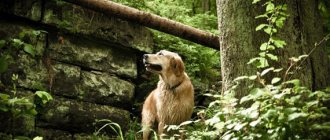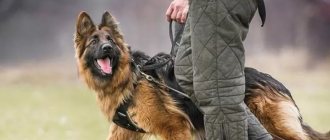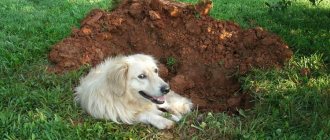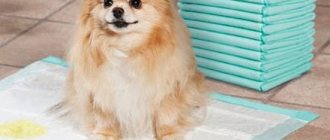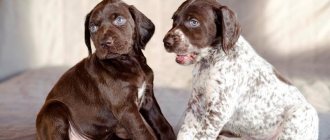History of the breed
The first information about Puli shepherd dogs dates back to the second half of the tenth century. People did not take part in its creation. All changes are made by nature, naturally.
Bullets with a white coat are considered to be purebreds. Those with dark coats have ancestors in whose veins the blood flows mixed with other types of shepherd dogs (German, French).
The birthplace of the bullet is Hungary. But there are two versions of how these dogs got to Hungarian lands:
1. Bullets were brought to Hungary in the thirteenth century by the Cumans from Syria and India. 2. The bullets arrived in Hungary from China along with the nomads. There is a possibility that Hungarian Shepherds and Tibetan Terriers have common ancestors.
The development of the breed took place in Hungary. The name “Puli” itself appeared in 1751. Initially, the only purpose of the Hungarian Shepherd was herding, guarding and driving livestock to other pastures.
But the bullets performed their service only during the daytime. Due to their not too large dimensions, the owners did not trust them with their flocks, fearing that at night they would not be able to protect the sheep from large predators. Therefore, at night they were replaced by kuvasz, larger and more powerful dogs.
Over time, when the number of farmers keeping flocks of sheep decreased, Hungarian water dogs began to be used during hunting for fetching and as gun dogs.
The popularity of the bullet is growing not only in its homeland. European countries also appreciated and accepted these amazing animals. Americans have a special attitude towards them, all because of their fur, reminiscent of the hairstyles of Rastafarians. In the mid-twentieth century, Hungarian Shepherds entered the territory of the former Soviet Union.
Origin story
Puli is a very ancient breed, so it is difficult to reliably talk about its origin. Presumably, dogs of this type entered the territory of Hungary along with nomadic tribes and their herds. While large dogs guarded property, small, agile dogs herded livestock. By the way, bullets herd sheep in a very original way: they jump on the animals’ backs or jump over them, and very rarely bite the “heels”, as other small “shepherds” do, such as corgis.
Today, puli are very rarely used as shepherds, they are mainly kept as companions.
Thanks to centuries-old selection, it was possible to preserve such qualities as extraordinary endurance, ingenuity, and hard work, but at the same time slightly refine the appearance and turn shaggy wool into an exquisite dreadlock coat. American scientists analyzed the word “bullets” and suggested that among the ancient Sumerians it meant: driven or attacking.
Purposeful breeding of herding dogs in Hungary began only in the 18th century. In 1924, the first club of national breeds was created and a stud book was opened. The first description of the breed was made a little earlier, in 1912. Since 1930, bullets have been actively exported to other European countries, as well as America and Japan. The breed appeared in Russia after the 50s, but is still small in number.
Video review about the Puli dog breed
Breed standard
In 1915, the first standard of the Hungarian Shepherd Dog was adopted officially, at the international level. At first, representatives of the breed were divided into 4 species, which were distinguished by height at the withers:
1. Dwarf - about 24 cm. 2. Small - up to 38 cm. 3. Working - up to 42 cm. 4. Large - at least 47 cm.
Due to the fact that not all varieties could cope with herding work, and because of this they were less in demand, changes were made to the standard in 1924. Now only Hungarian Shepherd dogs of medium height were recognized.
According to the existing standard, the weight of adult bullets is 10-15 kg. , height about 37-45 cm .
A distinctive feature of the water dog is its long cords of wool, like those of the Rastafarians. The eyes are almost completely hidden under the fur, and the lush tail, curled over the back, blends so tightly with the general coat that the rise of the back line (from the withers to the croup) is visually visible.
In general terms, the body type has a square format. The muscles are well developed, although the long coat hides both the muscles and the curves of the body.
A small round head rests on a muscular, not too long neck. The hanging ears are V-shaped.
The dark eyes are not too large, set obliquely. The eyelids are not droopy. The look is lively, indicating the mind and developed intelligence of the bullet.
The muzzle is not sharp. The nose is small and black. Lips are not drooping. The jaws are strong and have a scissor bite.
The back line is straight, the loin is short. The chest is deep. The croup is slightly sloping.
The limbs are straight with well-developed muscles. The structure of the front and hind legs is the same. The pads are elastic. The stride is wide, the trot gives way to jumps. The movements are energetic.
The tail is set high and curled into a ring.
The skin is without folds and highly pigmented.
The coat of mature Hungarian Shepherds is flowing and thick. The guard hair is hard and coarse. There is a thin undercoat. The wool hangs to the ground and spontaneously curls into thick cords 20-30 cm long.
At the beginning of the twentieth century, black bullets were considered the most popular. Then the Hungarian Shepherd Dogs with white coats took the lead. Now the following colors of this breed are allowed according to the standard:
1. Black. 2. White. 3. Gray. 4. Deer (there is a black mask on the face). 5. Black with a gray or rusty red tint.
During exhibition shows, white water dogs are judged separately from representatives of the breed with other coat colors.
Origin of the breed
Puli dog
Puli is a dog that belongs to the oldest species. According to some sources, the history of the breed began more than 6 thousand years ago. Historical sources say that the same dogs were kept in Ancient Rome. It is not known exactly which country is considered the birthplace of the breed. There are opinions that this is Hungary, but other experts say that the dogs were brought there by the Turks.
Presumably the species migrated along with the Magyars or Cumans (Pechenegs) tribes from the Urals. Externally, the dogs are similar to the Komondor, a breed native to Hungary.
Nomads valued puli shepherd dogs and could pay a year’s wages for one dog. The characteristics of the dogs were mainly valued, their intelligence, understanding of where to drive the herd, at what speed, and ability to protect sheep from wolves, because the thick layer of wool makes it difficult for predators to injure the guard.
Puli is a dog breed that gave rise to new varieties in the 18th century:
- pumi - the result of crossing a bullet with a briar;
- Mudi - a mixture of Shepherds and Spitz dogs with Puli.
The first breed standard was described in 1915, but dogs have been appearing as show specimens since 1923.
For reference! The breed was officially recognized in the 30s of the 20th century, and the standard was approved 20 years later.
Maintenance and care
Photo source: https://kupi-dog.ru/shenki/shhenok-porody-puli-2018_2_puli/
The water dog is able to perfectly adapt to life outdoors and indoors. So such a pet can be kept in an enclosure, in a private house or in an apartment. If the dog lives in the yard, take care of a high fence. The bullet can jump very high, so it can overcome a low fence with ease. Install the enclosure in a place protected from direct sunlight and not in a draft.
When keeping in an apartment, be sure to allocate a place for your pet. Make sure that your Hungarian Shepherd does not suffer from the heat. In the summer, the apartment should have a cool climate, and it is also important that the dog has clean, fresh water available around the clock.
Daily long walks are vital for a water dog. Ten-minute walks a day are not enough; due to such a boring lifestyle, the dog may even get sick or his character will deteriorate.
You need to walk your shepherd twice a day. This takes at least 2-3 hours. At the same time, provide your pet with physical activity. Favorite pastimes are obstacle course running and chasing games. Daily training contributes to the mental and physical development of the animal.
If you take a walk with a bullet in crowded places, near highways, be sure to keep your dog on a leash and muzzle. The fact is that the Hungarian Shepherd has a highly developed hunting instinct. Having seen the intended target, it is capable of rushing after the “victim”, despite the owner’s commands. The ideal place for training a shepherd is a deserted park or yard.
It is necessary to properly care for your pet. If you carry out timely procedures indicated in the list below, your water dog will be healthy and beautiful:
- Caring for the Puli's long and unusual coat is not difficult. Brushing consists of untangling the dreadlocks with your hands rather than combing out the fur with a brush. Without such procedures, Hungarian Shepherd dog cords may become tangled. The fur on the face and along the underline requires a little shaping as it grows. The lack of shedding makes caring for your dog easier.
- We bathe only when necessary. Scheduled bathing is recommended once a year. Puli takes a very long time to dry; using a hair dryer in this case can harm both the coat and skin of the shepherd. “Human” detergents cannot be used; buy only special bullets for bathing, intended for dogs with the specified type of coat. The skin of these animals is very sensitive, take this fact into account when choosing a shampoo.
- Once every 6-8 days we inspect and clean the ears. If you notice excessive accumulations of ear discharge or inflammation, immediately take your pet to a veterinarian.
- We examine the eyes regularly for inflammation and injury. Wipe as needed if discharge accumulates.
- Nails rarely need to be trimmed, since active water dogs themselves grind them down on the road surface during walks.
- To clean your shepherd's teeth, it is recommended to buy special bones, which are sold at a pet store or pharmacy. Although you can use a brush and toothpaste designed for dogs.
You don’t have to spend a lot of money on food for your Hungarian Shepherd. Her dimensions are not miniature, but she does not eat much. You can feed the bullets dry ball or natural products. The main thing is that the food is balanced and of high quality.
The diet with a natural feeding method should include vegetables, fruits, cereals, meat products, and low-fat dairy products. We feed adults once or twice a day. At the same time, you need to adhere to the norms so as not to overfeed your pet. The fact is that representatives of the Hungarian breed are prone to obesity and diabetes.
It is prohibited to introduce the following foods into a water dog’s diet: tubular bones, fatty meat, milk, and sweets.
Care and maintenance
- Dreadlocks grow throughout your life. They don't shed and don't need to be brushed. It is necessary once a year to separate the dreadlocks with your fingers from roots to ends so that they do not get confused with each other.
- Wash no more than once every two months. After washing, dry thoroughly with a towel. An adult dog will be completely dry in 4 days.
- It is recommended to contact professional groomers.
- Clean your ears every three days.
- Clean your eyes as mucous discharge occurs.
- Dental care. It is enough to examine the teeth and oral cavity of the bullet once a week. As for the care itself, during a thorough examination you should pay attention to: The condition of the gums - if they are red and inflamed, it is recommended to contact a veterinarian who will recommend special medications or remedies;
- Teeth color – ideally, it should remain normal, without plaque (you can clean it yourself) and purulent formations. To maintain teeth in good condition, special bones and toothpastes for dogs can be very useful;
- Dental health – check for loose or broken teeth. Between them there should also be no food residues, the accumulation of which causes the animal to develop an unpleasant odor from the mouth and subsequently rot;
- The presence of tartar - in this case, it is impossible to do without the intervention of a veterinarian and its removal. It should also be noted that an important factor for the health of the bullet - and in particular the teeth - is proper balanced nutrition.
Remember that all dog grooming procedures help to establish a relationship with the dog and train him to be disciplined. Regular checking of the Puli puppy will develop into a kind of obligatory and pleasant communication procedure. If you notice any changes in behavior or find any unexplained sores or redness, contact your veterinarian.
Health
On average, a Hungarian Shepherd can live 12-13 years. Her health is good, her body’s immune defense is strong. These dogs are hardy and mentally stable. This characteristic of the breed, with regard to health, has remained unchanged for several centuries.
It is worth noting the bullet’s predisposition to the following diseases:
- Hypothyroidism – occurs due to insufficient amounts of hormones in the thyroid gland.
- Onychodystrophy is a pathology of the claws.
- Portosystemic shunt is an anastomosis between the veins of the gastrointestinal tract and the caudal vena cava.
- Erythematous pemphigus - usually occurs on the front of the head (the bridge of the nose and around the eyes), as well as on the ears.
- Tail shortening.
- Missing teeth.
- Dysplasia – brings severe pain, the dog limps and moves little.
- Diseases of the cardiovascular system.
- Dermatitis is a skin disease that requires long-term treatment.
- Diabetes.
Character
The Water Shepherd is very attached to its owner and to all family members. The breed's energy supply seems to never end. Therefore, the owner in the form of a homebody will not suit him. Puli is ready to accompany any member of the household, just to be nearby, run, jump and, of course, protect.
The Hungarian Shepherd makes an excellent watchman. At the slightest noise or when strangers come, this dog barks loudly. If the owner, family members or pets are in danger, the Puli turns from an affectionate, intelligent dog into a fearless, formidable guard.
The Shepherd is gentle and protective towards children at home. But he doesn’t show much friendliness towards children from other families. Unfamiliar adults, their children, animals kept in other houses are strangers.
So the puli instinctively strives to keep them out of its territory, protecting and protecting its family. To avoid problems when guests come, the shepherd dog needs to be properly raised and trained.
Training and education
Assertiveness in tandem with food and verbal rewards is the basis of training a Hungarian Shepherd. Rudeness and physical punishment are excluded during training. In response to such an appeal, the bullet may completely refuse to carry out commands.
The water dog has a sharp mind and quick wit. Based on these characteristics, she is easy to train. She quickly remembers commands and understands her owner perfectly.
But on the other hand, representatives of the breed have innate stubbornness. They are able to make decisions independently. If the lesson seems boring to such a dog, it may refuse to complete the tasks.
Therefore, it is important to train the bullet in a playful way. It is important to interest your pet. As a result, you can quickly achieve excellent results.
Interesting Facts
- The Hungarian Water Dog leads its flock in a very unique way. She guides the sheep by jumping on their backs and jumping over them.
- The water dog loves water (hence the name) and is an excellent swimmer. There is only one problem - after water treatments, long strands of wool dry for about 4 days.
- Rough treatment of a Hungarian Shepherd by its owner can lead it to deep depression and even cardiac arrest due to the resulting stress.
- In ancient times, a Hungarian Shepherd puppy was compared in price to a cow. It was impossible to get such a pet cheaper.
- In most cases, the puli were looked after very poorly; the food of the shepherd dogs was often a few pieces of black bread.
- In ancient times, for any mistake, the owner could hang a water dog over a well. But even such cruel treatment did not “kill” the love for people in the shepherd dogs.
Education and training
Two dogs
It is important to properly raise and socialize any breed of dog. Otherwise, the pet may grow uncontrollable and even aggressive. A dog's behavior depends solely on training, but not on its innate character.
Puppy puppy should be obedience trained as early as possible. Dogs are very smart - in nature they know how to skillfully guide a flock of sheep, and even more so when given a command to fetch a stick or overcome obstacles.
Early training allows you to achieve excellent results in obedience and agility, while it is more difficult to work with older animals, especially with skittish dogs. Not only can they not be trained at all, but they can also skillfully manipulate the owner, having understood how to get what they want from a person.
Puppies are happy to work with a trainer, but it is important to find an approach to the dog, not to put pressure on it, and not to practice obedience skills in a harsh manner. Forceful methods are incompatible with the wayward Hungarian; they extinguish the dog’s natural drive and make him inhibited. Puli is unlikely to accept IPO methods, but he will master the security standards of ZKS and OKD.
First skills for a puppy:
- approach to call;
- shrinkage;
- prohibition of unwanted actions.
As a reward for young animals, they use a delicacy by gesture, and simply distract them from forbidden actions. As dogs grow older, they are taught to use voice commands.
Outdoor games are very important
A mandatory condition of education is active movements and games. Pulis are an inquisitive breed. Dogs will be happy to follow commands and quickly remember them.
In an effort to quickly raise a dog, one should not forget to praise him once again; pets feel a kind word and affection. Sometimes you have to give the bullet the freedom to come up with its own game. Provided they are properly maintained and maintain physical activity, dogs remain functional for a long time. Sometimes an old dog cannot be distinguished from a three-year-old one.
Pros and cons of the breed
Puli, with its unusual appearance, has gained popularity in many countries. This dog is perfect for large families, for those who lead an active lifestyle and have a lot of free time to pay attention to their Hungarian Shepherd pet.
Like any other breed, the Puli has its pros and cons, which you should familiarize yourself with before purchasing a puppy.
Advantages:
1. Exotic appearance. 2. Devotion. 3. Excellent guard qualities. 4. Love for children. 5. Unpretentiousness in food. 6. Performance.
